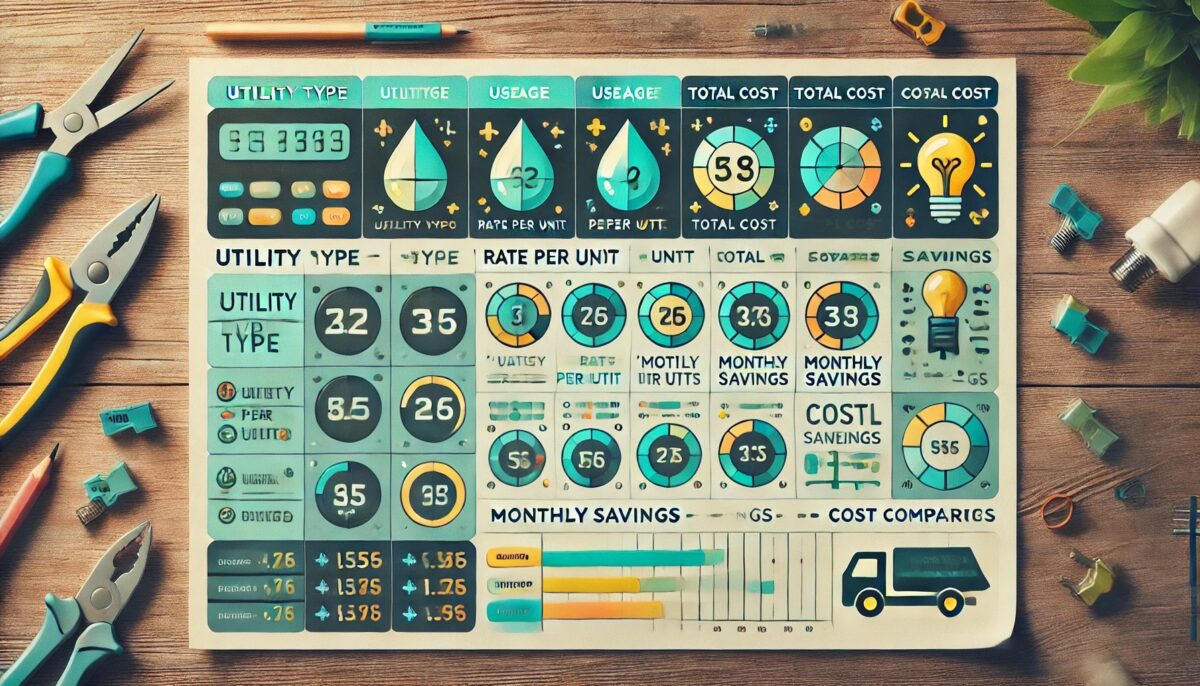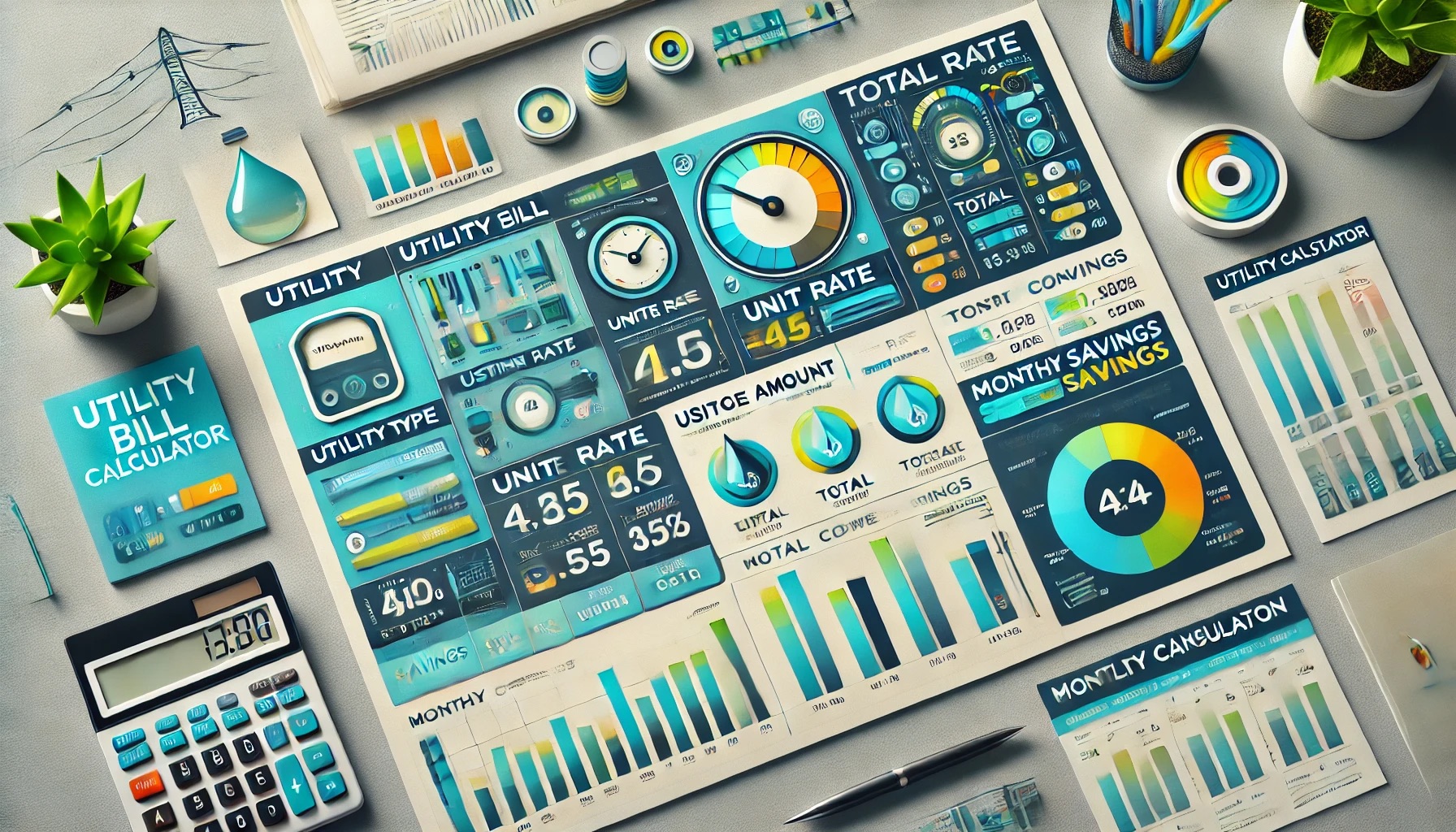Save Money with Examples: Utility Bill Calculator Template

Utility bills are an integral component of everyday life, encompassing the essential costs associated with services like electricity, gas, water, sewer, and more. These recurring expenses impact households and businesses alike, making them a significant part of monthly financial planning. Whether you’re looking to reduce costs, gain better control over your finances, or simply understand your consumption habits, mastering utility bills is a vital step toward financial efficiency.
By comprehending the nuances of these bills and utilizing tools like a utility bill calculator, you can unlock a more structured approach to managing resources. These calculators not only help track monthly expenses but also highlight areas where savings can be achieved. Such tools are indispensable for identifying excessive usage, monitoring trends, and creating actionable plans for financial improvement.
In this comprehensive guide, we delve into the various types of utility bills, uncover strategies to understand and manage them effectively, share expert tips to cut costs, and provide examples of easy-to-use calculator templates. By the end, you’ll have the knowledge and resources needed to simplify your utility expenses and save money for other priorities in life.

What Are Utility Bills?
Utility bills are invoices for services required to maintain a household or business. These services include:
- Electricity: Charges based on the kilowatt-hours (kWh) consumed.
- Natural Gas: Costs related to heating and cooking, measured in therms or cubic feet.
- Water: Charges based on the volume of water consumed, often measured in gallons.
- Sewer: Fees for treating wastewater, typically proportional to water usage.
- Trash and Recycling: Fees for waste collection services.
- Additional Utilities: Phone, internet, cable TV, and streaming services.
These bills vary depending on factors such as location, usage, and service providers.
Why Use a Utility Bill Calculator?
A utility bill calculator is a practical tool to track and manage your utility expenses. It allows you to:
- Understand Your Spending: Break down costs by utility type.
- Identify Savings Opportunities: Highlight areas where usage can be reduced.
- Plan Your Budget: Forecast monthly and yearly expenses.
- Track Trends: Compare costs across months or years to identify patterns.
Types of Utility Bills
Here’s an overview of the most common utility bills:
1. Electric Bill
The cost of electricity usage is often the highest utility expense. It’s measured in kilowatt-hours (kWh) and influenced by factors like:
- Appliances used.
- Seasonal heating or cooling.
- Peak and off-peak rates.
2. Natural Gas Bill
Natural gas is typically used for heating, cooking, and water heating. Bills fluctuate based on:
- Seasonal demand (higher in winter).
- Energy efficiency of appliances.
- Regional rates.
3. Water Bill
Water usage charges depend on household consumption and local rates. Additional fees may include water service charges and taxes.
4. Sewer Bill
This bill covers the cost of treating wastewater. It’s usually calculated as a percentage of water usage.
5. Trash and Recycling
Charges vary depending on the volume of waste, recycling services, and municipal regulations.
6. Additional Utilities
Phone, internet, and streaming services (e.g., Netflix, Spotify) fall under this category. These are optional but increasingly necessary in modern households.
Factors Affecting Utility Costs
- Location: Rates vary by region due to local policies and infrastructure.
- Season: Heating in winter and air conditioning in summer can spike energy bills.
- Household Size: Larger families consume more resources.
- Appliances: Older or inefficient appliances increase utility usage.
- Usage Patterns: Leaving lights or devices on unnecessarily can inflate bills.
Tips to Reduce Utility Bills
1. Energy Efficiency
- Upgrade to energy-efficient appliances with an Energy Star rating.
- Replace traditional bulbs with LED lighting.
- Seal windows and doors to prevent heat loss.
2. Optimize Heating and Cooling
- Use programmable thermostats to regulate temperature.
- Maintain HVAC systems regularly.
- Insulate your home to reduce heating/cooling costs.
3. Water Conservation
- Fix leaks promptly.
- Install low-flow fixtures.
- Run dishwashers and washing machines with full loads.
4. Reduce Standby Power
- Use smart power strips.
- Unplug unused devices.
5. Shop Around
- Compare rates from utility providers to ensure you’re getting the best deal.
- Look for bundled service discounts.
Using a Utility Bill Calculator
A utility bill calculator simplifies financial tracking. Here’s how to use one effectively:
- Input Monthly Expenses: Enter costs for electricity, gas, water, and other services.
- Add Usage Details: Include metrics like kWh consumed or gallons of water used.
- Analyze Trends: Review graphs or summaries to identify cost drivers.
- Forecast Future Bills: Use past data to estimate upcoming expenses.
Utility Bill Calculator Templates
To make tracking even easier, here are ready-to-use templates:
1. Basic Utility Bill Calculator
- Tracks monthly expenses for electricity, gas, water, and more.
- Features automatic total and average calculations.
2. Monthly Bill Tracker
- Includes sections for recurring bills, due dates, and amounts.
- Helps prevent missed payments.
3. Electricity Usage Calculator
- Breaks down costs by appliance or device.
- Identifies energy consumption trends.
4. Comprehensive Utility Tracker
- Combines all utility categories with graphs and insights.
- Ideal for businesses and households.
Additional Resources for Saving
Streaming Services Discounts
Save on streaming services like Netflix and Spotify by purchasing prepaid cards or subscriptions through reliable platforms such as RoyalCDKeys. This allows you to:
- Avoid regular billing.
- Take advantage of seasonal discounts.
Microsoft Office for Templates
Use Excel for creating and managing utility templates. Affordable licenses for Microsoft Office are available at RoyalCDKeys.
Conclusion
Utility bills are a significant expense, but understanding and managing them doesn’t have to be daunting. By using tools like a utility bill calculator and following simple tips to reduce consumption, you can optimize your expenses and achieve financial stability.
Start by downloading a suitable template and analyzing your utility data. Small changes today can lead to substantial savings tomorrow. Take control of your finances and enjoy the peace of mind that comes with better money management.
Source: Save Money with a Utility Bill Calculator Examples – Template
Don’t forget to explore our previous post: Rubric Template: Streamline Project and Performance Assessment






